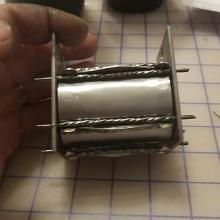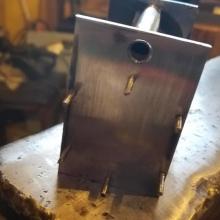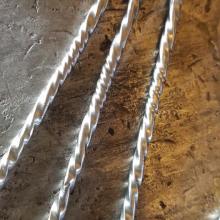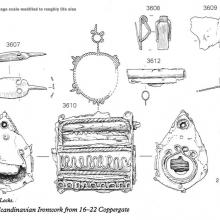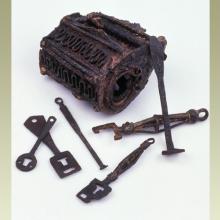11th c. Norse Padlock, Jorvik dig
Based on a lock found in York, England, Jorvik dig site. Although I have worked with metal before: knives, hinges, etc. I have never made anything this intricate. I thought this project would allow me to refine my detail skills and patience.
Viking Era (850-1000 a.d.) barrel padlocks with a spring tine free-arm mechanism were found at York, Jorvik and Coppergate settlements, and in Denmark with a similar locking mechanism as found in Uppland, Sweden. All of these locks operate on a similar mechanism: the spring tine free-arm.
The locks were all in two parts: the free-arm and the lock body. The body was usually a barrel or box riveted or braised together while the free-arm was inserted into the body and secured with a spring tine mechanism.
The lock body concealed the springs, obfuscating the mechanism, when the lock was secured. A key was inserted on the opposite end as the spring tine hasp to collapse the springs to allow the hasp to be removed from the pad lock.
The various pieces of the original lock were made from what we would now call wrought iron. This iron would have been smelted in a bloomery, compressed and shaped into rough blocks. the nature of the bloom creates a carbon rich environment (CO2, and CO) due to the wood fires needed to generate the heat. if left in the bloom too long or at too high of a heat, some carbon would migrate to the iron accumulated there. At best this would have been a poor, low carbon steel. All pieces would have been cut from this stock with chisels/shears, hammered into shape, and finished with files. For this project, not having a supply of wrought iron, I chose to use a mild, cold rolled steel stock and worked all pieces as above. I, however, did not make my tools, but used hammer, chisels, punches, and files.
Using a rough description and archaeological drawings (Ottoway, 1989) finished dimensions were determined to be a 2" diameter lock barrel, and an overall length of 3". Analysis of the description, drawings, and pictures of the original piece (Jorvik, 2020) were done to determine components and construction methods/order.
First the sheets were cut to form the lock barrel and free-arm tube. These were then hammered into shape on the edge of an anvil. Next, the end plates were cut and marked with the barrel and tube to determine where the rivets would be placed and the holes were punched. Rivets were formed from strips cut and hammered round, with the ends filed to a smaller diameter (to fit the punched holes).
The free-arm was formed from a bar of steel, hammered round across most of it's length, but squared and tapered at one end. Thin, hammered strips of steel were then brazed to this tapered end, and hardened to a spring temper. Then, a larger diameter hole was punched into one of the end plates and filed square to accommodate the tapered end of the free-arm with the springs collapsed against it.
Ottoway described sets of three plates around the barrel, five in total, with a sixth serrated plate separating the free-arm tube and the lock barrel. I have determined that the sets of three plates are a rivet and decorative components. I made the rivet from twisted strips, per Ottoway's description and then brazed a raised plate for decoration. This fin was hammered out, punched and brazed to the rivet. An additional twisted strip was then brazed to this set. These would now be larger, decorative rivets.
The rivets above were then set through the end plates of the lock along with the free-arm tube, forming the lock body. Holes were then punched through the front lock plate for the free arm spring mechanism to pass through and through the rear plate for the key.
Ottaway, P. (1989). p. 992, Locks, Anglo-Scandinavian ironwork from 16-22 Coppergate, York, c. 850-1100 A.D. (Vol. 2). York: publisher not identified.
Ottaway, P. (1989). p. 1101, cat. fig. 34, Padlock and keys, Anglo-Scandinavian ironwork from 16-22 Coppergate, York, c. 850-1100 A.D. (Vol. 2). York: publisher not identified.2012-2020 York
Archaeological Trust (2020), Padlock and Key, downloaded on 16 Mar 2020 from https://www.jorvikvikingcentre.co.uk/about/jorvik-artefact-gallery/lock…
"The Ancient Art of the Locksmith". Buildingconservation.com. Retrieved from www.buildingconservation.com 10/22/18.
“The History of Padlocksâ€, Viking era, downloaded from <https://www.historicallocks.com/en/site/h/articles/the-history-of-padlo… 10/22/18>.


